|
55th Festival of Short Films, Oberhausen, Germany (30 April – 5 May, 2009)
Short Films, Livelier than Ever
by Hassan Dezvareh
|
 Oberhausen has no tourist attractions, nor has it a special place in Germany’s economy or history. It is an area with coal mines shut down long ago and smelting plants for iron and other metals closed to workers. Nevertheless, 55 years ago, a number of pioneer leftist futurists founded a short film festival. Since its onset, the festival has come in confrontation with local officials thanks to its “unconventional” political and cultural implications. Although its managers have changed several times, its cultural policies have remained the same. Perhaps, now the major reason for the prominence of this festival in Germany is its consistency and its loyalty to the ideals of its founders. And perhaps that is why leftist academics and intellectuals as well as groups and parties critical of traditional approaches have always supported the festival’s policies regardless of their own individual views. For instance, prominent philosopher, sociologist and conductor, Theodor Ludwig Wiesengrund Adorno, wrote in a letter to film critic, sociologist, and journalist, Siegfried Kracauer: “Whatever which is refined and acceptable thing in German cinema today, most probably comes from the Oberhausen Festival.” Oberhausen has no tourist attractions, nor has it a special place in Germany’s economy or history. It is an area with coal mines shut down long ago and smelting plants for iron and other metals closed to workers. Nevertheless, 55 years ago, a number of pioneer leftist futurists founded a short film festival. Since its onset, the festival has come in confrontation with local officials thanks to its “unconventional” political and cultural implications. Although its managers have changed several times, its cultural policies have remained the same. Perhaps, now the major reason for the prominence of this festival in Germany is its consistency and its loyalty to the ideals of its founders. And perhaps that is why leftist academics and intellectuals as well as groups and parties critical of traditional approaches have always supported the festival’s policies regardless of their own individual views. For instance, prominent philosopher, sociologist and conductor, Theodor Ludwig Wiesengrund Adorno, wrote in a letter to film critic, sociologist, and journalist, Siegfried Kracauer: “Whatever which is refined and acceptable thing in German cinema today, most probably comes from the Oberhausen Festival.”
During its relatively long life, this festival has provided a platform for numerous less famous filmmakers from all over the world. The festival’s officials have always taken pride in this. Roman Polanski says: “Short film is a major step for every young filmmaker. That was how I started and Oberhausen was a significant starting point for me.” This was the first Western European cultural event that supported Eastern European filmmakers during the Cold War era. It showed their films and introduced them to the West. For years, its motto was “a way towards our neighbors.” Wim Wenders says: “I have been watching films at this festival for years now and every year it has been so pleasurable. These experiences have had a major role in my career as filmmaker.”
It appears that loyalty to progressive ideals and supporting visual innovations in short films has turned this festival into a visual phenomenon in Germany and made the country’s politicians aware of its importance. Germany’s former chancellor, Gerhard Schroeder, who led the country from 1998 to 2005 had said: “Oberhausen Festival has undoubtedly made history. Both short films and the festival have remained young. This powerful and creative characteristic is still visible in this festival.” These words were welcomed by the audience and were widely reflected in German media.
After I listened to Oberhausen’s mayor and top cultural official of the state at the opening ceremony, once again, I came to believe that this was one of the most important cultural events in Germany and as the cultural official had said: “This year, Oberhausen will attract thousands of enthusiastic filmmakers and its programs will go beyond simply screening movies.” There were more than a thousand visitors from fifty countries and over 600 films were shown within the six days of Oberhausen Festival. The Festival had received 5,742 films from 91 countries and that is probably the largest number of films such a film festival has ever received. Out of that figure, 4,433 films were from other countries and the rest were made in Germany. There were 51 films from 31 countries in international competition section. Unfortunately, there were none from Iran. There were also 35 films in the national competition section and 36 films from 36 countries in the children and young adults section with 12 in the video clips section. Dr. Lars Henrik Gass, the festival’s director says: “While festivals are the only place to evaluate many films, perhaps arranging programs that would reveal filmmakers’ creativity become even more important. The video clips section is a historical experiment. The festival has contributed to the understanding of this form of art. A festival should be prepared to accept innovations and present new aesthetical standards.”
SUBSCRIBE
[Page: 122]
|
|
|
|
|
President & Publisher
Massoud Mehrabi
Editors:
Sohrab Soori
Translators:
Sohrab Soori
Behrouz Tourani
Zohreh Khatibi
Saeed Khamoush
Contributors
Shahzad Rahmati
Saeed Ghotbizadeh
Advertisements
Mohammad Mohammadian
Art Director
Babak Kassiri
Ad Designers
Amir Kheirandish
Hossein Kheirandish
Cover Design
Alireza Amakchi
Correspondents
E.Emrani & M. Behraznia (Germany)
Mohammad Haghighat (France)
A. Movahed & M. Amini (Italy)
Robert Richter (Switzerland)
F. Shafaghi (Canada)
B. Pakzad (UAE)
H. Rasti (Japan)
Print Supervisors
Shad-Rang
Noghreh-Abi
Gol-Naghsh
Subscription & Advertising Sales
Address: 10, Sam St., Hafez Ave., TEHRAN, IRAN
Phone: +98 21 66722444
Fax: +98 21 66718871
info@film-magazine.com
Copyright: Film International
© All rights reserved,
2023, Film International
Quarterly Magazine (ISSN 1021-6510)
Editorial Office: 5th Floor, No. 12
Sam St., Hafez Ave., Tehran 11389, Iran
*
All articles represent views of their
authors and not necessarily
those of the editors
|
|
|

